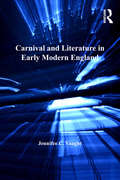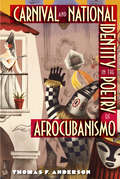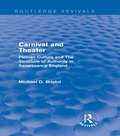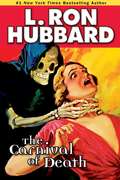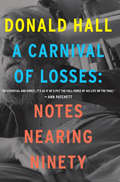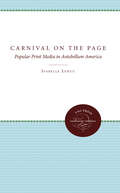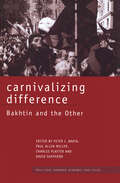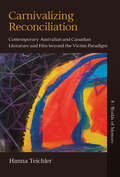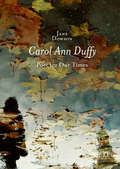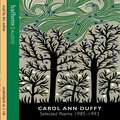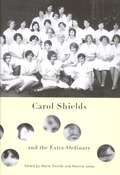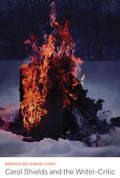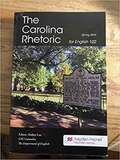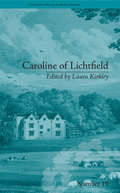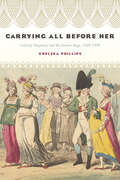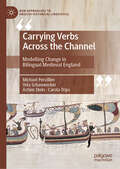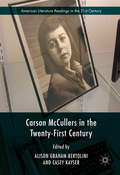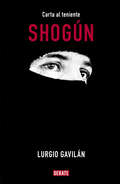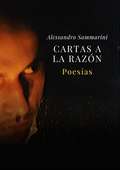- Table View
- List View
Carnival and Literature in Early Modern England
by Jennifer C. VaughtCarnival and Literature in Early Modern England explores the elite and popular festive materials appropriated by authors during the English Renaissance in a wide range of dramatic and non-dramatic texts. Although historical records of rural, urban, and courtly seasonal customs in early modern England exist only in fragmentary form, Jennifer Vaught traces the sustained impact of festivals and rituals on the plays and poetry of sixteenth- and seventeenth-century English writers. She focuses on the diverse ways in which Shakespeare, Spenser, Marlowe, Dekker, Jonson, Milton and Herrick incorporated the carnivalesque in their works. Further, she demonstrates how these early modern texts were used-and misused-by later writers, performers, and inventors of spectacles, notably Mardi Gras krewes organizing parades in the American Deep South. The works featured here often highlight violent conflicts between individuals of different ranks, ethnicities, and religions, which the author argues reflect the social realities of the time. These Renaissance writers responded to republican, egalitarian notions of liberty for the populace with radical support, ambivalence, or conservative opposition. Ultimately, the vital, folkloric dimension of these plays and poems challenges the notion that canonical works by Shakespeare and his contemporaries belong only to 'high' and not to 'low' culture.
Carnival and National Identity in the Poetry of Afrocubanismo
by Thomas F. Anderson“Traces the ways that Cuban poets dealt with issues of national identity, reflected in their views of Afrocubanismo, often in response to historical changes in public and official opinions on the most visual manifestation of Afro-Cuban culture: carnival.”—Choice “Uncovers a wealth of literary texts, primarily poems, that chart the impact of las comparsas, Afro-Cuban festival dances, on mainstream Cuban life. . . . Investigates the ways in which the relationship between racial and ethnic divisions, and between castes and classes, created a literary movement full to the brim with emotional and sensational resonances.”—Wasafiri “Underscores the sociopolitical and historical contexts of these poems which have shaped the literary production and message of the Afrocubanismo movement. . . . A tour de force.”—Callaloo “Successfully plumbs the position of the Afro-Cuban performer and brings into sharp relief the way politicians historically sought to affect all elements of Cuban culture.”—New West Indian Guide Carnival and National Identity in the Poetry of Afrocubanismo offers thought-provoking new readings of poems by seminal Cuban poets, demonstrating how their writings affected the development of a recognizable Afro-Cuban identity. Thomas Anderson examines the long-running debate between the proponents of Afro-Cuban cultural manifestations and the predominantly white Cuban intelligentsia, who viewed these traditions as “backward” and counter to the interests of the young Republic. Including analyses of the work of Felipe Pichardo Moya, Alejo Carpentier, Nicolás Guillén, Emilio Ballagas, José Zacarías Tallet, Felix B. Caignet, Marcelino Arozarena, and Alfonso Camín, this rigorous, interdisciplinary volume offers a fresh look at the canon of Afrocubanismo and offers surprising insights into Cuban culture during the early years of the Republic.
Carnival and Theater: Plebian Culture and The Structure of Authority in Renaissance England (Routledge Revivals)
by Michael D. BristolIn this title, first published in 1985, Michael Bristol draws on several theoretical and critical traditions to study the nature and purpose of theatre as a social institution: on Marxism, and its revisions in the work of Mikhail Bakhtin; on the theories of Emile Durkheim and their adaptations in the work of Victor Turner; and on the history of social life and material culture as practiced by the Annales school. This valuable work is an important contribution to literary criticism, theatre studies and social history and has particular importance for scholars interested in the dramatic literature of Elizabethan England.
Carnival of Death, the
by L. Ron HubbardDiscover intrigue and suspense. Working deep undercover to break up a purported drug ring operating at Shreve's Mammoth Carnival, US narcotics agent Bob Clark discovers first one and then another headless body. Others believe the gruesome murders are solved after four tribal headhunters working for the show suddenly disappear, but Clark suspects someone else is the real killer. When he finds himself seized by the very same headhunters, Clark sincerely hopes his hunch is right, since the point of a very sharp knife is aimed at his neck! ALSO INCLUDES THE MYSTERY STORY "THE DEATH FLYER""...this horror/mystery tale roars to life through the kaleidoscopic auditory fabric of its carnival setting....Though the plot kicks off right away, the production increasingly gains traction as more of the cast chime in to layer the tale. Recommended."--Library Journal
A Carnival of Losses: Notes Nearing Ninety
by Donald HallNew essays from the vantage point of very old age, once again “alternately lyrical and laugh-out-loud funny,”* from the former poet laureate of the United States * New York Times Donald Hall lived a remarkable life of letters, one capped most recently by the New York Times bestseller Essays After Eighty, a “treasure” of a book in which he “balance[s] frankness about losses with humor and gratitude” (Washington Post). Before his passing in 2018, nearing ninety, Hall delivered this new collection of self-knowing, fierce, and funny essays on aging, the pleasures of solitude, and the sometimes astonishing freedoms arising from both. He intersperses memories of exuberant days—as in Paris, 1951, with a French girl memorably inclined to say, “I couldn’t care less”—with writing, visceral and hilarious, on what he has called the “unknown, unanticipated galaxy” of extreme old age. “Why should a nonagenarian hold anything back?” Hall answers his own question by revealing several vivid instances of “the worst thing I ever did," and through equally uncensored tales of literary friendships spanning decades, with James Wright, Richard Wilbur, Seamus Heaney, and other luminaries. Cementing his place alongside Roger Angell and Joan Didion as a generous and profound chronicler of loss, Hall returns to the death of his beloved wife, Jane Kenyon, in an essay as original and searing as anything he's written in his extraordinary literary lifetime.
Carnival on the Page: Popular Print Media in Antebellum America
by Isabelle LehuuIn the decades before the Civil War, American society witnessed the emergence of a new form of print culture, as penny papers, mammoth weeklies, giftbooks, fashion magazines, and other ephemeral printed materials brought exuberance and theatricality to public culture and made the practice of reading more controversial. For a short yet pivotal period, argues Isabelle Lehuu, the world of print was turned upside down. Unlike the printed works of the eighteenth century, produced to educate and refine, the new media aimed to entertain a widening yet diversified public of men and women. As they gained popularity among American readers, these new print forms provoked fierce reactions from cultural arbiters who considered them transgressive. No longer the manly art of intellectual pursuit, reading took on new meaning; reading for pleasure became an act with the power to silently disrupt the social order.Neither just an epilogue to an earlier age of scarce books and genteel culture nor merely a prologue to the late nineteenth century and its mass culture and commercial literature, the antebellum era marked a significant passage in the history of books and reading in the United States, Lehuu argues.Originally published 2000.A UNC Press Enduring Edition -- UNC Press Enduring Editions use the latest in digital technology to make available again books from our distinguished backlist that were previously out of print. These editions are published unaltered from the original, and are presented in affordable paperback formats, bringing readers both historical and cultural value.
Carnivalizing Difference: Bakhtin and the Other (Routledge Harwood Studies in Russian and European Literature #Vol. 6)
by Paul Allen Miller David Shepherd Charles Platter Peter I. BartaIt has seemed at times that there is no neutral territory between those who see Bakhtin as the practitioner of a kind of neo-Marxist, or at least materialist, deconstruction and those who look at the same texts and see a defender of traditional, liberal humanist values and classical conceptions of order, a conservative in the true sense of the term. Arising from a conference under the same title held at Texas Tech University, Carnivalizing Difference seeks to explore the actual and possible relationships between Bakhtinian theory and cultural practice. The introduction explores the changing configurations of our understanding of Bakhtin's work in the context of recent theory and outlines how that understanding can inform, and be informed by, culture both ancient and modern. Eleven articles, spanning a wide range of periods and cultural forms, then address these issues in detail, revealing the ways in which Bakhtinian thought illuminates, sometimes obfuscates, but always challenges.
Carnivalizing Reconciliation: Contemporary Australian and Canadian Literature and Film beyond the Victim Paradigm (Worlds of Memory #8)
by Hanna TeichlerCriminal justice inquiries may be the most historically dramatic means for coming to terms with traumatic legacies, but it is in the more subtle social and cultural processes of “memory work” that most individuals encounter historical reconciliation in practice. This book analyzes, within the realms of national literature and film, recent Australian and Canadian attempts to reconcile with Indigenous populations in the wake of forced child removal. As Hanna Teichler demonstrates, their systematic emphasis on the subjectivity of the victim is “carnivalesque,” temporarily overturning discursive hierarchies. Such fictions of reconciliation venture beyond simplistic narratives and identities defined by victimization, offering new opportunities for confronting painful histories.
Carnivalizing Reconciliation: Contemporary Australian and Canadian Literature and Film beyond the Victim Paradigm (Worlds of Memory #8)
by Hanna TeichlerTransitional justice and national inquiries may be the most established means for coming to terms with traumatic legacies, but it is in the more subtle social and cultural processes of “memory work” that the pitfalls and promises of reconciliation are laid bare. This book analyzes, within the realms of literature and film, recent Australian and Canadian attempts to reconcile with Indigenous populations in the wake of forced child removal. As Hanna Teichler demonstrates, their systematic emphasis on the subjectivity of the victim is problematic, reproducing simplistic narratives and identities defined by victimization. Such fictions of reconciliation venture beyond simplistic narratives and identities defined by victimization, offering new opportunities for confronting painful histories.
Carol Ann Duffy: Poet for Our Times
by Jane DowsonThis is the only monograph to consider the entire thirty-year career, publications, and influence of Britain's first female poet laureate. It outlines her impact on trends in contemporary poetry and establishes what we mean by 'Duffyesque' concerns and techniques. Discussions of her writing and activities prove how she has championed the relevance of poetry to all areas of contemporary culture and to the life of every human being. Individual chapters discuss the lyrics of 'love, loss, and longing'; the socially motivated poems about the 1980s; the female-centred volumes and poems; the relationship between poetry and public life; and poetry and childhood and written for children. The book should whet the appetite of readers who know little of Duffy's work to find out more, while providing students and scholars with an in-depth analysis of the poems in their contexts. It draws on a wide range of critical works and includes an extensive list of further reading.
Carol Ann Duffy: Selected Poems
by Carol Ann DuffySELECTED POEMS is a collection of poetry chosen by Carol Ann Duffy from her first four acclaimed novels: STANDING FEMALE NUDE, SELLING MANHATTAN, THE OTHER COUNTRY and MEAN TIME (winner of the Whitbread Poetry Award). It is read by the author - the first time she's recorded her work as an audiobook.
Carol Shields and the Extra-Ordinary
by Marta Dvorak Manina JonesCarol Shields and the Extra-Ordinary begins with a previously unpublished article by Shields. In the essays that follow, international scholars employ a variety of theories and methodologies in their analyses of her work, including narrative theory, cultural criticism, feminist analysis, psychoanalytic approaches, tropological explication, theories of authorship, and ficto-criticism to demonstrate how Shields's writing represents a genuine revision of literary realism in which the ordinary is subject to contemplation and not just celebration.
Carol Shields and the Extra-Ordinary
by Manina Jones Marta DvorakCarol Shields and the Extra-Ordinary begins with a previously unpublished article by Shields. In the essays that follow, international scholars employ a variety of theories and methodologies in their analyses of her work, including narrative theory, cultural criticism, feminist analysis, psychoanalytic approaches, tropological explication, theories of authorship, and ficto-criticism to demonstrate how Shields's writing represents a genuine revision of literary realism in which the ordinary is subject to contemplation and not just celebration.
Carol Shields and the Writer-Critic
by Brenda Beckman-LongThroughout her literary and critical career, Canadian writer Carol Shields (1935-2003) resisted simple categorization. Her novels are elegant puzzles that confront the reader with the ambiguity of meaning and narrative, yet their position within Shields' critical feminist project has, until now, been obscured.In Carol Shields and the Writer-Critic, Brenda Beckman-Long illuminates that project through the study of Shields' extensive oeuvre, including her fiction and criticism. Beckman-Long brings depth to her analysis through close readings of six novels, including the award-winning The Stone Diaries. Elliptical, open-ended, and concerned with women writing about women, these novels reveal Shields' critique of dominant masculine discourses and her deep engagement with the long tradition of women's life writing. Beckman-Long's original archival research attests to Shields' preoccupation with the changing efforts of waves of feminist activism and writing.A much needed reappraisal of Shields's innovative work, Carol Shields and the Writer-Critic contributes to the scholarship on life writing and autobiography, literary criticism, and feminist and critical theory.
The Carolina Rhetoric For English 102
by USC Columbia The Department of EnglishThe Carolina Rhetoric for English 102
Caroline of Lichtfield: by Isabelle de Montolieu (Chawton House Library: Women's Novels #19)
by Laura KirkleyThomas Holcroft’s 1786 translation of Isabelle de Montolieu’s novel is a textual encounter between a rather conventional Swiss woman and a British radical. Just as Montolieu did in her own translations, Holcroft reworked parts of the novel to make it more appealing to his intended audience.
Carolinian Alphabet (Island Alphabet Books)
by Lori PhillipsThis book is part of the Island Alphabet Books series, which features languages and children's artwork from the U.S.-affiliated Pacific. Each book contains the complete alphabet for the language, four or five examples for each letter, and a word list with English translations. The series is published by PREL, a non- profit corporation that works collaboratively with school systems to enhance education across the Pacific.
Carrying All before Her: Celebrity Pregnancy and the London Stage, 1689-1800 (Performing Celebrity)
by Chelsea PhillipsThe rise of celebrity stage actresses in the long eighteenth century created a class of women who worked in the public sphere while facing considerable scrutiny about their offstage lives. Such powerful celebrity women used the cultural and affective significance of their reproductive bodies to leverage audience support and interest to advance their careers, and eighteenth-century London patent theatres even capitalized on their pregnancies. Carrying All Before Her uses the reproductive histories of six celebrity women (Susanna Mountfort Verbruggen, Anne Oldfield, Susannah Cibber, George Anne Bellamy, Sarah Siddons, and Dorothy Jordan) to demonstrate that pregnancy affected celebrity identity, impacted audience reception and interpretation of performance, changed company repertory and altered company hierarchy, influenced the development and performance of new plays, and had substantial economic consequences for both women and the companies for which they worked. Deepening the fields of celebrity, theatre, and women's studies, as well as social and medical histories, Phillips reveals an untapped history whose relevance and impact persists today.
Carrying Verbs Across the Channel: Modelling Change in Bilingual Medieval England (New Approaches to English Historical Linguistics)
by Michael Percillier Yela Schauwecker Achim Stein Carola TripsThis book examines grammatical changes that took place in the medieval language contact situation between English and French from 1066 until 1500. It investigates structural copying phenomena and their connection with the lexicon, finding that copying of lexical verbs with a predicate-argument structure accelerated wider grammatical changes, and shows why the traditional notion of borrowing should be replaced with the more adequate concept of copying. The authors start by taking a fresh look at the relationship between Old French and Middle English in light of recent developments in the fi eld of linguistics, arguing that what has traditionally been seen as a diglossic situation (i.e., as contact between the dominating speakers of French and the native speakers of English) should instead be analysed through the framework of bilingualism. The two contact scenarios under scrutiny are the ones between Old French and Middle English and Middle English and the contact variety of Anglo-French. On the basis of their case studies they develop a holistic model of contact-induced change that integrates the bilingual individual as well as the speech community and its sociolinguistic background. This book will be of interest to students and scholars of language history and change, language contact and acquisition, sociolinguistics, multilingualism, and psycholinguistics.
Carson McCullers in the Twenty-First Century (American Literature Readings in the 21st Century)
by Alison Graham-Bertolini and Casey KayserThe contributors to this volume use diverse critical techniques to identify how Carson McCullers’ writing engages with and critiques modern social structures and how her work resonates with a twenty-first century audience. The collection includes chapters about McCullers’ fiction, autobiographical writing, and dramatic works, and is groundbreaking because it includes the first detailed scholarly examination of new archival material donated to Columbus State University after the 2013 death of Dr. Mary Mercer, McCullers’ psychiatrist and friend, including transcripts of the psychiatric sessions that took place between McCullers and Mercer in 1958. Further, the collection covers the scope of McCullers’ canon of work, such as The Heart Is a Lonely Hunter (1940), The Member of the Wedding (1946), and Ballad of the Sad Café (1943), through lenses that are of growing interest in contemporary literary studies, including comparative transatlantic readings, queer theory, disability studies, and critical animal theory, among others.
Carta al teninente Shogún
by Lurgio Gavilán"Allí estás, con uniforme, pasamontaña, rastrillando el fusil. Listo para abrir fuego. Mirándome". En un acto epifánico, inexplicable, un militar decide detener el fuego en las alturas andinas y salvar la vida de un niño adoctrinado por Sendero Luminoso, Lurgio Gavilán. Décadas después, pasado el fragor del combate y el tiempo de las heridas, ese muchacho convertido en hombre busca a su viejo salvador para tratar de entender las motivaciones de su cariño y de su dureza. Como toda epístola, Carta al teniente Shogún apela a un interlocutor, aunque de este solo sepamos lo que el autor revela. Las arms que utiliza son retóricas e intelectuales, y si bien su propósito es personal, su motivación es filosófica: ¿qué lleva a un hombre a matar a otro? ¿Cómo una vida construida entre campos y riachuelos se convierte en una tragedia cruenta por cordilleras y cuevas? ¿Cuál es el idioma que se debe emplear para referir a los parientes perdidos, a las víctimas acuchilladas y a los pueblos arrasados? ¿Y cuál para los colibríes? ¿Quién y cómo ejerce el poder y a quién debe rendir cuentas? Toda misiva es un intento por aproximar una visión del mundo a otra. Lurgio Gavilán ha escrito esta carta para el teniente Shogún, pero también para sí mismo y para todos aquellos que buscan humanidad donde parece no haberla.
Cartas a la razón
by Marlo LópezEste camino mío es un viaje a lo largo de veinte años, en el que hay un amor no correspondido que lleva inevitablemente a una crisis de identidad, desarrollándose luego en una nueva relación que llega a la coronación del sueño de amor. Se concluye con un intenso análisis del período vivido, una especie de reelaboración del pasado. De lo alto de tantos estados emocionales se describe la visión en el tiempo, para impulsarse con la mente a buscar y a encontrar personales verdades. La búsqueda de mí mismo comenzó con la intención de amar, con el deseo de enamorarme. El amor es vivido con una reflexión racional y una participación infantil que descubre uno de los planes más bajos del miedo: el miedo de amar. Al revelarse los miedos se descubren las ansias, defensas personales que hacen huir de un peligro irracional, hasta revelar la verdad, en este caso yo mismo.
Cartas a un joven médico
by Federico Ortiz QuezadaLa relación entre la reflexión filosófica y el estudio de la medicina es mucho más íntima de lo que pensamos... A veces son exactamente lo mismo.Las cartas literarias han sido un medio privilegiado para que los sabios de diversas disciplinas transmitan sus conocimientos a los jóvenes, ansiosos o inseguros por iniciarse en su profesión. Ahí están los celebres ejemplos de Rilke, Vargas Llosa y Siqueiros. Pero esta preocupación por compartir los conocimientos y experiencias de toda una vida no es exclusiva de escritores y artistas; también la comparten los hombres de ciencia, y tal es el caso de Federico Ortiz Quezada. Cartas a un joven médico conjuga las dos grandes pasiones de su autor: la medicina y la literatura. A través de 28 cartas, el doctor Ortiz Quezada se manifiesta por una medicina con vocación humanista, al tiempo que reflexiona sobre el sentido último de esta profesión, sobre la naturaleza del sufrimiento y sobre la condición pluridimensional del ser humano. Asimismo, hace una severa crítica de los principales vicios de la medicina moderna: la superespecialización, la tecnificación y la burocratización.Este libro puede leerse como una historia de la ciencia médica, cuyo foco o eje rector es la relación entre escritura y medicina, pues para el doctor Federico Ortiz Quezada ambas disciplinas persiguen el mismo fin: la comprensión del hombre y lo humano. Una y otra se complementan en la misma búsqueda.
Las cartas del Boom
by Mario Vargas Llosa Gabriel García Márquez Carlos Fuentes Julio CortázarEL BOOM EN PRIMERA PERSONA (DEL PLURAL) Cuatro de los más grandes autores contemporáneos en español a través de su correspondencia compartida. «La obra de García Márquez es incomprensible sin la de Cortázar, y la de Cortázar es incomprensible sin la de Vargas Llosa, y se establece toda una red que corresponde a algo muy real. Porque yo sé que cada uno de nosotros es muy consciente de lo que están haciendo los demás».Carlos Fuentes, 1968 «Este libro reúne, por primera vez, la correspondencia entre los cuatro principales novelistas del Boom latinoamericano: Cortázar, Fuentes, García Márquez y Vargas Llosa. Los dos últimos recibieron el Premio Nobel, y los dos primeros lo merecían; a nadie hubiera sorprendido que lo obtuvieran. Esta conversación entre cuatro amigos brillantes y exitosos nos ofrece un acceso sin precedentes a sus relaciones personales y colectivas, con todos sus encuentros y desencuentros, y nos abre una ventana privilegiada a la literatura y la política latinoamericanas, especialmente durante un periodo crucial de su historia moderna, entre 1959 y 1975. »Las cartas del Boom narra el momento de máximo auge de este cuarteto, en el que los creadores parecían empezar a escribir menos solos para tocar en conjunto como parte de una misma literatura, y ahonda en ese reconocimiento y esa regeneración de un pasado en común. »Encontrar cuatro grandes escritores en un contexto histórico casi sin paralelo, comunicándose durante varios años para dialogar sobre novela, literatura, historia latinoamericana, sus propias biografías y la dinámica de sus ideas dentro de ese contexto, es absolutamente único. Las páginas de este libro cuentan esa historia».Los editores
Cartas extraordinarias
by María NegroniHomenaje, arte poética y gozo se unen en este libro único, exquisito y feliz, en el que textos e imágenes componen una correspondencia milagrosa. Homenaje, arte poética y gozo se unen en este libro único, exquisito y feliz, en el que textos e imágenes componen una correspondencia milagrosa. Como un regreso y un reconocimiento a las obras y autores que formaron la biblioteca de nuestra infancia y adolescencia, María Negroni escribió este conjunto de "cartas extraordinarias" que iluminan el mundo en que vivieron y crearon Louisa May Alcott, Emilio Salgari, Charles Dickens, Mark Twain, Jack London y tantos otros grandes escritores del siglo XIX, cuyas narraciones serán siempre el corazón de nuestro ADN literario. Se trata de cartas cuidadosamente apócrifas, a veces improbables, o imposibles por anacrónicas, a veces incluso dirigidas a personajes de ficción que, sin ignorar las circunstancias biográficas, históricas y sociales de los corresponsales, emprenden, casi con saña, una empedernida reflexión en torno a los costos y peligros de la actividad literaria. Los bellísimos y delicados collages de Fidel Sclavo funcionan, en cada caso, a modo de preciso y sugestivo comentario. La crítica ha dicho... «Negroni entabla una correspondencia con las lecturas de su propia infancia para continuar preguntándose, mediante las voces de otros escritores, sobre las hendiduras de la actividad literaria.» Mariana Amato
